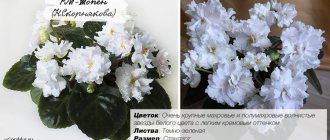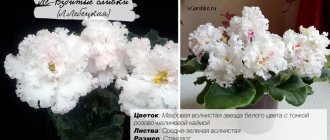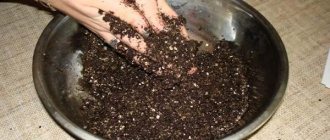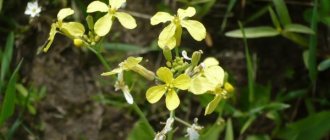Mini and semi-mini violets (with names and varieties) differ from traditional types in their impeccable symmetry, active flowering, strong peduncle and leaves, which are beautifully arranged in “tiles”. They are spectacular in a group, but the main advantage of small Saintpaulias is the ability to place a large number of plants in a limited area. This is important for collectors.
What mini violets look like
Bokarneya: home care and popular types
There are 3 known mini varieties: semi-mini violets, miniature and microminiature types.
Mini violet
The diameter of the rosette in half-minis ranges from 15 to 20 cm. If they are transplanted into a larger pot, they will quickly move into the category of standard violets.
The rosette of mini varieties does not exceed 15 cm in diameter. To prevent these varieties from growing, the lower tier of leaves are constantly removed and the flower is replanted.
The diameter of the rosette of microviolets is no more than 8 cm, the length of the leaves is only 0.6-1.2 cm. These little ones are the most demanding to care for. The leaf blades are shaped like a heart or a circle with wavy edges. The central vein at the base of the leaf is thicker and lighter than the other veins. Babies have more leaves than standard violets. Their flowers are no more than 4 cm in diameter.
Features of reproduction
At home, mini-violets are usually propagated by cuttings. This procedure is best carried out in the warm season. To grow a new flower, you need to separate a green and healthy leaf without damage from the mother plant, and then root it in the ground as an independent plant. To root the cuttings, you can use a soil mixture of the following components:
- nutrient soil - 42%;
- peat - 15%;
- crushed charcoal - 3%;
- perlite - 10%;
- vermiculite - 15%;
- small pieces of sphagnum - 15%.
Let's take a closer look at the propagation process of mini-violets:
- Wash the cut leaf of the mother plant in warm water and place it in a fungicide solution to prevent fungal infections.
- Cut off a small piece (about 1 cm) of the lower part of the leaf stem with a sharp, clean knife. Sprinkle the cut area with crushed charcoal.
- Dig a small hole about 1 cm deep in a pot of soil. Lower the cutting into it at an angle of 45° and lightly sprinkle it with soil.
- Water the soil a little with warm water, cover the container with the cuttings with film. Place it under a bright source of artificial lighting. Moisten the soil in the pot as needed.
- It takes several weeks for the cutting to root. As a result, small babies with new leaves appear on the young sprout.
- When the children have 6-7 new green leaves, they are planted in individual pots with ordinary soil for indoor plants.
If the lower leaves of a young violet begin to deteriorate, they are carefully removed and more soil is poured around the stem.
Description of common varieties
How to replant violets at home
Common varieties of semi-miniature violets are:
- Aca's Happy Star - the flower of this variety is shaped like a large double pink star, with dark burgundy rays radiating from the center.
- Aca's Johnny Redcoats - the variety has a dark lilac flower color, the tips of the petals are white, and the flower petals are velvety.
- Adirondack Moon is a variety with variegated leaves. The inflorescences are double or semi-double white. In the center the petals are yellow and lilac-blue.
Mini flower in hands
Popular among miniviolets are:
Alan's Blue Star is a variety with large blue flowers. This variety is interesting because its petals have small dots of coral color. The shape of the flower resembles a star with wavy edges and a thin white stripe along the edge. The leaves of this variety are small, dark green in color, with teeth along the edge.
- Bahamian Sunset is a variety with a neat rosette of burgundy double flowers and a thin white stripe along the edge.
- Gleeful Elf is a variety with a compact rosette of delicate blue flowers, along the edges of which there is a white-green border. The leaves are light green.
Microvarieties are represented by such varieties as:
- Chantaspring is a violet with a rosette of small yellow bells.
- Rob's Twinkle Blue - blue violet. The rosette of the flower is only 5-6 cm in diameter.
- Child's play - a variety with heart-shaped leaves and white flowers with a lilac shadow on the petals.
LiveInternetLiveInternet
UZAMBARA VIOLET (SAINTPAULIA). Sometimes Baron Saint-Paul-Hillers is called the discoverer of Saintpaulia, but this is not at all true. It all started in 1892, when the governor of East Africa, Baron Adalbert Emil Walter Radcliffe la Tannaix von Saint-Paul, and his bride, escaping the heat in the shade of trees while walking, discovered completely unfamiliar purple flowers. As you may have guessed, the name “Saintpaulia” was received in honor of the name of the discoverer. The flowers found were sent to Germany to a passionate gardener and orchid collector, Walter Saint-Paul's father, Ulrich von Saint-Paul. For identification, the flowers were sent by Ultrich Saint-Paul to the director of the botanical garden, Hermann Wendland, in Hanover, who classified them as belonging to the Gesneriaceae family. 1893 is considered the year of the “birth” of violets: this year they were demonstrated at international flower exhibitions, were first described in the magazine “Gartenflora” and aroused great interest. Shanghai Rose. Exotic. Goddess of beauty. Lord of the Rings. Bullfight. Frosty Cherry. Black Pearl. Goddess of Beauty sp. Sensation.
Svetlana. Passion. Mysterious Island.
Midnight Frolic. Pearl Zephyr. Powwow. Bridal bouquet. Aphrodite. Apache Midnight. White Queen. Ivory Coast.
Indian summer. White Magic. Wishful Thinking.
Russian girl. The mirror of one's heart.
The Virgin Mary. Lyons Spectacular.
Gilian. Smile. Apache Shadows. Tropic Heat.
Rhapsody in White. Pink flamingo. Blue Velvet. Powder Keg. Portrait of a Stranger. Arapahoe. Snezhana.
Sergeant Pepper. Ruffled Skies. Ness Red Velvet.
Blue Dragon.
Arcturus.
Sugar Rose. Frozen in Time. Glimmar.
Irish Laughter.
Crystal Plum. Pink Sensation. San Mateo Blues.
Red Lantern. Pat Tracy. Ness Orange Pekoe.
Lel.
Icy Sunset. Ruffled Skies - 2. Kostina Fantasy. Emergency. Rain Man. Alys Crinolines. Mermaid.
Atlantis. Beloved Daughter. Apache Freedom. Stone Flower. Blue Flash. Rainbows Quiet Riot. Red Velvet.
Kings Ransom.
Louisiana Lullaby. Scandal. Pink Carnation. Plauful Spectrum. Startrick.
Music Box Dancer. Tanya. Misty Cloud. Strawberry Glade.
Iceberg.
Angelique in Anger.
African Night. Golden Autumn.
Lyons Night Owl.
Vologda Lace. Yoke.
Mas Prince Froggie.
Dolce Vita.
Hello, Sunshine. Arctic Frost. Pirates Gold. Nautilus.
Lyons Pirates Treasure - sp. Lyons Pirates Treasure. Firehouse.
Cherry Bomb.
Royal Rage. Valeska Blue. Love and pigeons.
Cherry Blizzard.
Swan Lake. Rodeo Glory.
Blue-eyed Russia. Odyssey.
Summer Twilight.
Apache Primrose.
Angels Lace.
Snow Leopard.
White Lily. Kumparsita. Headed Kate. Lyubasha.
Precise Strike. Galactic Storm.
Sunny girl. Switzerland.
Sunny Boy. Party Cloudy. Storms Eye.
Margaret. Gioconda. Enchantment.
Harmony.
Spring Rose.
Caring for mini violets at home
Caring for mini varieties is easier than standard ones. They get sick less often, and it is convenient to propagate them by cuttings. However, you need to know certain subtleties of care so as not to destroy the plant.
Temperature
Uzambara violet - home care
Miniature violets are more demanding on temperature conditions. The optimal temperature for them is 21-24°C. Tender leaves should be protected from direct sunlight. The little ones do well in partial shade. Diffused lighting is ideal for them: through a thin curtain fabric or mosquito net.
Lighting
Daylight hours for babies should be at least 12 hours. If there is a lack of natural light, they are placed on racks under lamps.
Watering
Due to the small size of the pot, miniature Saintpaulias have to be watered more often, guided by the drying of the top layer of soil. In summer, plants need more frequent watering. The portion of water should be small. The optimal measurement for watering is a medical syringe.
Mini Saintpaulias are watered with settled or filtered water at room temperature. You need to pour water into the pot until it begins to flow out through the drainage holes into the pan. After half an hour, the water from the pan must be drained.
When watering, direct a stream of water to the edge of the pot so that it does not fall on the bottom row of leaves.
Attention! Mini varieties tolerate temporary drought more easily than excessive watering. If the top layer of soil does not dry out, there is a high probability of rotting of the roots and lower tier of leaves.
In addition, to maintain moisture, Thumbelina can be watered through a tray, using coal and sphagnum moss as drainage. It is possible to use wick irrigation.
Watering option
Spraying
Plants are sprayed against pests and to prevent diseases with the pesticide "Confidor". The procedure is performed outdoors on a cloudy day when the temperature is above +15°C. Only when the leaves are completely dry is the pot brought into the room.
Closer to autumn, you can spray violets with Actellik or Fitoverm for prevention. This spraying is done twice at intervals of a week.
In order for the little ones to develop faster and bloom better, they are sprayed with Epin once a month. To carry out the procedure, 1 ml of the product is diluted in a small amount of water, mixed thoroughly, then poured into 5 liters of water. All leaves should be evenly moistened with the solution.
Important! The prepared Epin solution cannot be stored.
If Thumbelina has been stressed in the form of drought or hypothermia, it is recommended to treat them with a 2% solution of succinic acid. To prepare a solution, 1 g of acid is diluted in 2 tablespoons of warm water, then poured into 2 liters of water. The prepared succinic acid solution can be used for 3 days.
Attention! Preventive spraying is carried out only when the minis do not bloom. If a flower has unopened buds, it should not be sprayed.
Humidity
For good health, babies need air humidity of 50-70%. Central heating systems in apartments dry out the air very much. Therefore, to create suitable conditions, micro varieties are placed in aquariums or placed on a tray with wet expanded clay and damp sand. You can also humidify the air by placing an open container of water on the windowsill next to the violets.
Priming
Since small pots are used for violets, the soil in them quickly becomes unusable: the soil cakes, its acidity changes, and the nutrients in it run out. To avoid problems with the development of babies, they are replanted 2 times a year, changing not only the soil mixture, but also the pot itself.
Micro varieties do not need loosening agents in the soil. A good soil for them is one that contains a sufficient amount of peat and sand. Expanded clay or sphagnum is used as drainage.
Feeding
As long as the plants are replanted 2 times a year, micro violets do not need fertilizer. If the condition of the plant shows that it needs mineral or organic fertilizing, then for minispecies they take the same fertilizers as for standard violets, but the concentration of the solution must be made 2 times less.
The optimal feeding will be complex factory fertilizers with potassium, nitrogen and phosphorus.
When and how does it bloom
How it blooms
The flowering period for small violets begins earlier than for standard species: 5-6 months after planting, the young cuttings will bloom. Despite their small size, their flower stalks are strong, form large flower caps and do not fall on the leaves.
The onset of the flowering period can be accelerated if you increase the daylight hours and lighting intensity for the babies, feed them with fertilizer with phosphorus, and trim the stepsons.
Appearance, shape and color of flowers
Since there are many small varieties of Saintpaulia, the appearance of their flowers varies greatly. The petals can be smooth or double, the flower shape can resemble a bell or a star. There are usually several flowers on one peduncle.
The color range of petals is also quite wide. It is interesting that the petals are monochromatic, sometimes they have one shade or another. The most common colors of mini Saintpaulias are white, white with a lilac shade, pink, pure blue or blue with a purple tint, red-burgundy, blue.
After the flowering period ends, seed pods form on the peduncle.
When they bloom (using the example of popular varieties)
If optimal conditions are created for mini, their flowering period will last from 9 to 12 months. It is noteworthy that the flowering period is not related to the time of year - the little ones bloom both in summer and winter. However, most varieties begin flowering in early spring.
Changes in care during the flowering period
During the flowering period, the babies are cared for in the same way as during the dormant period: they are watered and the necessary air humidity is maintained. You just need to remember that pests and diseases are not treated during the flowering period.
In addition, a characteristic feature of small species is that during the flowering period they have many stepsons that need to be pruned in order to prolong flowering and prevent the transition to the standard.
Growth Management
To prevent Saintpaulia from moving from the mini category to the standard category, it is necessary to strictly observe the storage conditions for violets.
By changing external conditions and farming techniques, you can control the growth of rosettes, their size and flowering:
- Planting plants in small pots. If you land in a container with a large diameter, the diameter of the rosette will also increase. Growth will slow down, and the flowering time will be delayed, since the plant must first master the soil, increase green mass, and only then the flowering period will begin;
The growth of mini violets can be controlled.
- Substrate composition. For miniature Saintpaulias, the soil should contain less yeast and fertilizer. A nutrient-rich substrate will cause the rosette to grow;
- Lighting. The brighter the light, the more compact the outlet. But direct mini-sun is contraindicated;
- Length of daytime hours. With a day length of 8 hours, the rosette grows well. To prevent it from becoming too large, it needs to be increased to 12 hours. Ideally, flowering requires 14 hours a day, but not all Saintpaulias respond well to this, so you need to carefully monitor the plant and perhaps reduce the time to 12-13 hours;
- Humidity. This factor has little effect on the size of the rosettes, but allows you to grow a healthy and strong plant.
Transplanting mini violets after purchase
After transplant
It is best to purchase a flower in autumn or spring. Immediately after purchase, the flower must be transplanted into a pot of the same size.
When replanting for the first time after purchase, the root system of the flower is left in its original state. As the plant develops, its root will also grow, so during subsequent transplants you need to do the following manipulations:
- Shake off old soil from the roots.
- Cut off part of the root system.
- Trim several rows of lower leaves, being careful not to disturb the shape of the rosette.
- Place drainage in the prepared new pot and add a layer of soil. The violet must be placed in a pot so that its leaves touch the edge of the pot. If necessary, the roots are further shortened.
- Add the required amount of soil, compacting it.
- Cover the plant with a plastic bag and keep it under it for 2 weeks.
Attention! After transplantation, the bush is not watered. It needs to be watered every other day.
Planting and transplanting
It is best to replant mini-violets in spring or autumn. While the standard can be moved from a smaller to a larger pot, the miniature varieties are in the same pot as before.
When transplanted into a larger pot, Saintpaulia may lose its miniature size and become a standard. Or its decorative effect will suffer, since the leaves will grow larger, and small flowers against the background of large leaf plates will look ugly.
It is possible to preserve the root system when transplanting a miniature viola only in the first year of life. In the future, a trunk that is too long will not fit into a small pot, so the Saintpaulia will have to be “partially” rooted. Because of this:
- As soon as the violet is removed from the vase, the earth is gently shaken;
- Cut off part of the root system;
- Some lower rows of leaves are removed, maintaining the symmetry of the rosette;
- Drainage is placed in the pot and a little soil is poured;
- The viola is placed in a container so that the leaf gills touch the edge; if the stem is too long and protrudes beyond the edge, then the roots are trimmed a little more;
- Fill in the soil, compacting it slightly.
Important! After transplanting, it is not necessary to water Saintpaulia immediately, only the next day. It should be placed in a plastic bag or greenhouse.
Keep the transplanted plant for 10-14 days in a greenhouse or bag under mild conditions:
- Under no circumstances should direct sunlight fall on Saintpaulia;
- The roots should be in warm, slightly moist soil.
When the trunk of a miniature viola reaches an “indecent” size, the plant takes root completely:
- To do this, leave 2-3 rows of the top leaves and remove the next rows in a circle so that the free stump is 1.5-2 cm;
- Cut off the top of the head along with the hemp, dry;
- Place a tablet of activated carbon dissolved in a glass of water so that the leaves lie on the edge and the stump is immersed 0.5-1 cm. You can root in peat, moss, hydrogel or familiar soil, for example, you are used to;
- After the roots appear, after 2-3 weeks, Saintpaulia is planted in a pot and placed in greenhouse conditions for another month, as when transplanting.
With the help of such manipulations, violets are not only rejuvenated, but also from the part of the plant that remains in the ground, good strong stepsons can be obtained. They differ from other planting materials in that they carry all the varietal characteristics of the mother plant. In addition, it takes root, grows and blooms faster.
Possible problems in growing mini violets
Flower growers may face some difficulties and problems. The presence of problems is indicated by the appearance of the plant: deformation of the leaves, change in their color, falling leaves and buds. The fact that the plant has been favored by parasites is indicated by the appearance of flying insects.
Diseases
The main diseases of small varieties are:
- Root rotting. This problem occurs with excessive watering and relatively low air temperature in the room. If it is detected, the affected roots must be cut off by treating the sections with crushed charcoal. Change the soil and optimize growing conditions.
- Burns on leaves (yellow spots on leaves). This problem occurs when the plant is exposed to direct sunlight. Damaged leaves must be cut off. For the violet, choose a new place, protected from the scorching sun.
Pests
Common pests of tiny varieties are thrips, slugs, and aphids. Signs of pests include a honey-like coating on the leaves and a sticky discharge on the leaves and stem. To combat parasites, the leaves of the plant should be washed with soapy water and sprayed with garlic infusion or diluted calendula tincture.
Sick violet
Other problems
Due to the fact that the lower rows of leaves of plants are close to the ground, there is a high probability of their rotting. In addition, due to errors in care, they may not bloom. Thus, Saintpaulia will not bloom unless the dormant period is artificially stopped by stimulating active flowering.
Thus, mini violets are popular among gardeners. Many are attracted by the variety of varieties and the opportunity to have a mini-flower garden on the windowsill. In addition, despite some peculiarities of care, in general the plants are unpretentious, have good immunity and develop quickly.
Mini garden
Growing on capillary mats
By using this modern material, two problems associated with preserving mini Saintpaulias can be simultaneously solved:
- Irrigation;
- And humidity.
But in order for the use of capillary mats to be effective, violets are planted a little differently.
The point is to use more moisture-absorbing components for drainage, for example, sphagnum moss with charcoal. Through the drainage holes, water will moisten the moss and hydrate the soil, keeping it evenly moist.
Evaporation of water from the surface of the mat increases the humidity around the miniatures. Here you need to ensure that the material is always wet.











